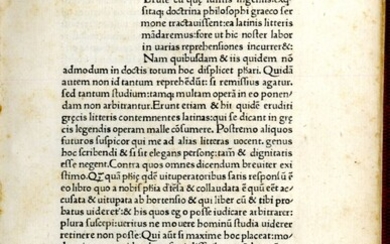Cicero's De finibus bonorum et malorum
Cicero's De finibus bonorum et malorum
Vindelinus de Spira, 1471
CICERO, Marcus Tullius (106-43). De finibus bonorum et malorum. Edited by Giorgio Merula. Venice: [Vindelinus de Spira for] Johannes de Colonia, [not after 9 November] 1471.
Editio princeps of Cicero’s treatise on the ancient philosophical schools, in a contemporary Augsburg binding. Possibly this edition may have been preceded by Sweynheym and Pannartz’s Scripta philosophica of Cicero, the second part of which appeared in September 1471. Ulrich Zel’s undated edition of the same work is based on this edition. Cicero’s efforts to translate and interpret Hellenistic philosophy, particularly Epicureanism and Stoicism, in his own time played a huge role in its survival and reception (refracted through the lens of Roman culture) in the Middle Ages; and indeed, that is his stated goal at the opening of De finibus. Wendelin von Speier took over his brother’s press after his death, and in the next three years published over 60 editions, largely of classical texts; this is the first of several Venetian editions of Roman classics edited by Merula. In his dedication, Merula refers to the recent invention of printing by the Germans; this contrasts with Ognibene's almost exactly contemporaneous dedication in Jenson's 1471 Quintilian (see lot 155), in which Jenson is credited with the invention and extolled as the new Daedalus. Only three other complete copies are recorded at auction in the last fifty years by ABPC; not in the Bavarian State Library—there are only two copies recorded in Germany, of which one is incomplete. HCR 5328; GW 6885; BMC V 157; Bod-inc C-289; IGI 2862; Goff C-565; ISTC ic00565000.
Royal quarto (272 x 181mm). 90 leaves (of 93, without blank B1 and final two blanks). Greek and Roman types. Large red initials (occasional light spotting and staining). Contemporary Augsburg blindstamped calf with author’s name stamped on upper board [Kyriss 84, EBDB w002075, Hirsch-Rolle I], clasps, reused manuscript quire guards (restored). Provenance: some early marginalia in several hands (trimmed) – acquired from Lucien Goldschmidt, New York, 19 October 1955.
View it on
Sale price
Estimate
Time
Auction House
Cicero's De finibus bonorum et malorum
Vindelinus de Spira, 1471
CICERO, Marcus Tullius (106-43). De finibus bonorum et malorum. Edited by Giorgio Merula. Venice: [Vindelinus de Spira for] Johannes de Colonia, [not after 9 November] 1471.
Editio princeps of Cicero’s treatise on the ancient philosophical schools, in a contemporary Augsburg binding. Possibly this edition may have been preceded by Sweynheym and Pannartz’s Scripta philosophica of Cicero, the second part of which appeared in September 1471. Ulrich Zel’s undated edition of the same work is based on this edition. Cicero’s efforts to translate and interpret Hellenistic philosophy, particularly Epicureanism and Stoicism, in his own time played a huge role in its survival and reception (refracted through the lens of Roman culture) in the Middle Ages; and indeed, that is his stated goal at the opening of De finibus. Wendelin von Speier took over his brother’s press after his death, and in the next three years published over 60 editions, largely of classical texts; this is the first of several Venetian editions of Roman classics edited by Merula. In his dedication, Merula refers to the recent invention of printing by the Germans; this contrasts with Ognibene's almost exactly contemporaneous dedication in Jenson's 1471 Quintilian (see lot 155), in which Jenson is credited with the invention and extolled as the new Daedalus. Only three other complete copies are recorded at auction in the last fifty years by ABPC; not in the Bavarian State Library—there are only two copies recorded in Germany, of which one is incomplete. HCR 5328; GW 6885; BMC V 157; Bod-inc C-289; IGI 2862; Goff C-565; ISTC ic00565000.
Royal quarto (272 x 181mm). 90 leaves (of 93, without blank B1 and final two blanks). Greek and Roman types. Large red initials (occasional light spotting and staining). Contemporary Augsburg blindstamped calf with author’s name stamped on upper board [Kyriss 84, EBDB w002075, Hirsch-Rolle I], clasps, reused manuscript quire guards (restored). Provenance: some early marginalia in several hands (trimmed) – acquired from Lucien Goldschmidt, New York, 19 October 1955.


![CICERO, Marcus Tullius De philosophia pars prima, id est, Academicarum questionum [...]. De finibus bonorum... CICERO, Marcus Tullius De philosophia pars prima, id est, Academicarum questionum [...]. De finibus bonorum...](https://gcp-la8-storage-cdn.lot-art.com/public/upl/16/CICERO-Marcus-Tullius-De-philosophia-pars-prima-id-est-Academicarum-questionum-De-finibus-bonorum_6604dc82964c8-thumb-44150300_1711594627-6604dc836bcae.jpg)




